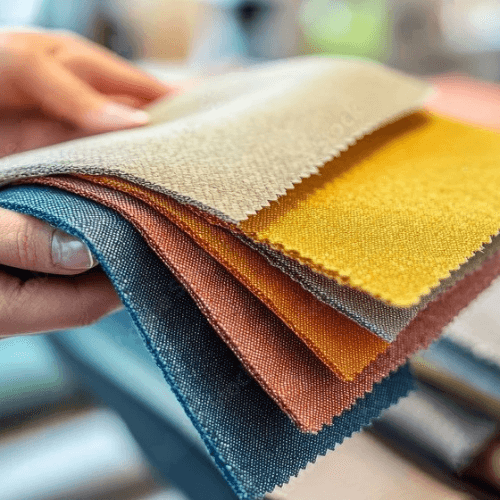Exploring Knit Fabrics: Essential Types, Benefits, and Drawbacks

Knit fabrics are an essential component of the textile industry, celebrated for their flexibility, comfort, and diverse applications. Made by interlocking loops of yarn, these fabrics are known for their stretchiness and breathability. This article delves into different types of knit fabrics, outlining their unique characteristics along with their advantages and disadvantages to aid in your fabric selection for sewing projects.
Types of Knit Fabrics
1.Jersey Knit
– Overview: Jersey knit is one of the most common types of knit fabric. It features a smooth surface on one side and a textured loop on the other.
– Advantages: This fabric drapes beautifully, offers excellent elasticity, and is relatively easy to sew.
– Disadvantages: Jersey can pill over time and may lose its shape after several washes.
2.Interlock Knit
– Overview: Interlock knit consists of two layers of fabric knitted together, making it thicker than jersey.
– Advantages: It provides good stretch and recovery while being less prone to wrinkling.
– Disadvantages: The added thickness can make it heavier and less breathable than other knits.
3.Rib Knit
– Overview: Rib knit features alternating rows of knit and purl stitches that create vertical ridges.
– Advantages: This type is highly stretchy and recovers well, making it ideal for cuffs, collars, and fitted garments.
– Disadvantages: Ribbed edges can curl if not properly finished.
4.French Terry
– Overview: French terry has a soft looped texture on one side with a smooth finish on the other.
– Advantages: It is soft to the touch, absorbent, and provides warmth without being overly heavy.
– Disadvantages: French terry is typically less stretchy than other knits and can snag easily due to its looped surface.
5.Pique Knit
– Overview: Known for its distinctive waffle-like texture, pique knit is often used in polo shirts.
– Advantages: It offers good breathability and moisture-wicking properties while being durable.
– **Disadvantages**: Pique can be heavier than other knits and may lack drape.
6.Ponte Knit
– Overview: Ponte is a double-knit fabric that is stable and holds its shape well.
– Advantages: It resists wrinkles effectively while providing good stretch.
– Disadvantages: Ponte can be less breathable than lighter knits.
7.Sweater Knit
– Overview: Sweater knits vary widely in texture but are primarily designed for warmer garments like sweaters.
– Advantages: They offer warmth and comfort during colder months.
– Disadvantages: Some sweater knits may require special care during washing to maintain their appearance.
8.Fleece Knit
– Overview: Fleece is a thick fabric with a deep pile that provides excellent insulation.
– Advantages: It is durable, quick-drying, and ideal for activewear or loungewear.
– Disadvantages: Fleece can be bulky and may not drape as well as lighter knits.
9.Hacci Knit
– Overview: Hacci knit features an open-knit construction with a soft brushed surface.
– Advantages: It is lightweight, cozy, and comfortable against the skin.
– Disadvantages: Hacci is prone to pilling and may have limited breathability.
## Benefits of Using Knit Fabrics
– **Elasticity**: The inherent stretchiness of knitted fabrics allows for comfortable movement in garments.
– **Softness**: Knitted materials are typically made from soft yarns that feel gentle against the skin.
– **Moisture Management**: Many knitted fabrics excel at wicking moisture away from the body, making them suitable for activewear.
– **Wrinkle Resistance**: Knitted fabrics tend to recover from creases better than woven fabrics do.
## Drawbacks of Knit Fabrics
– **Durability Concerns**: While stretchy, some knitted fabrics may be less durable than woven options; they can snag or pill over time with regular wear.
– **Shape Retention Issues**: Certain knits may lose their shape after multiple washes or prolonged use if not crafted from high-quality fibers.
– **Care Requirements**: Some types of knit fabrics may require special washing instructions to maintain their quality over time.
# Tips for Choosing the Right Knit Fabric
When selecting a knit fabric for your next project, consider these factors:
– **Project Purpose**: Determine whether you need a stretchy fabric (like jersey or spandex blends) or one that offers more structure (like ponte).
– **Seasonal Suitability**: Lighter knits such as jersey are ideal for summer clothing, while heavier options like fleece or sweater knits are better suited for winter garments.
– **Care Instructions**: Always check care labels before purchasing to ensure you’re prepared for any special handling required.
– **Comfort Level**: Consider how the fabric feels against your skin—softer materials like cotton or modal blends are great choices for sensitive skin.
### Conclusion
Knit fabrics offer an extensive range of options suitable for various sewing projects. By understanding the different types available along with their respective pros and cons, you can make informed decisions that enhance your creations. Whether you’re crafting casual wear or cozy sweaters, there’s a perfect knit fabric waiting to bring your designs to life!






